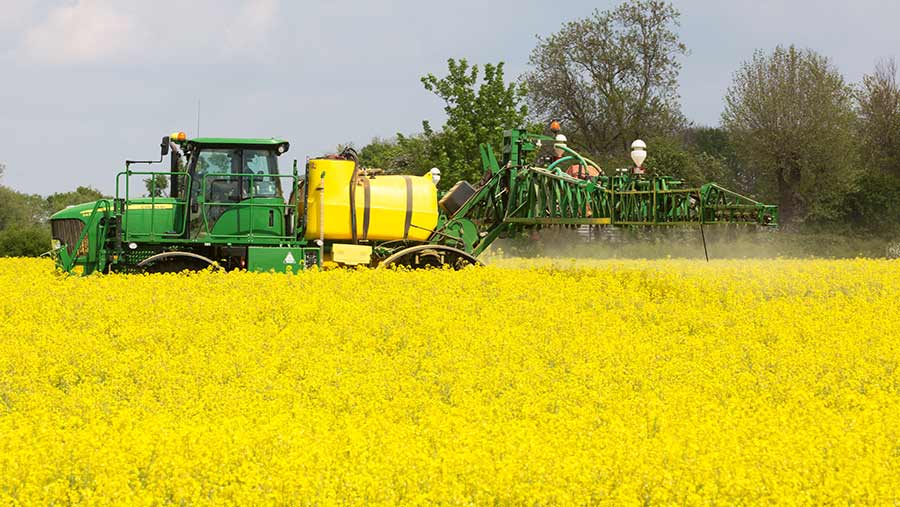Crop Watch: Cover OSR diseases with mid-flowering fungicide
 © Tim Scrivener
© Tim Scrivener With many British arable fields awash with yellow, thoughts are turning to mid-flowering fungicide sprays in oilseed rape crops for our agronomists this week.
In Kent, Kevin Knight says sclerotinia risk is moderate, but dews have been enough to encourage spore germination and trigger an infection alert. His treatment will cover sclerotinia, plus several other threats, to maintain green area and maximise oil content.
Further north in Yorkshire, light leaf spot is creeping back into oilseed rape, so Patrick Stephenson is opting for a product strong on this disease, too.
See also: Catch up with previous Crop Watch pieces
With wheat fungicide programmes in full swing, Marcus Mann stresses the importance of timing for the T1 spray, urging growers to aim for 60-70% emergence of leaf three on the main stem.
In the West Country, Giles Simpson says maize drilling is picking up pace and is recommending pre-emergence herbicide sprays to suppress early weed competition and protect yield.

Giles Simpson
West: Giles Simpson
Pearce Seeds (Somerset)
The last of the spring cereals have now been drilled, after cold, damp soils delayed drilling.
Thankfully, people waited for good conditions, rather than pushing on and drilling into bad seed-beds. With the weather now dry and set fair for a day or two, that was a good decision.
The wind has limited spraying days and many T0s were held up. This means the gap between T0 and T1 will be short, as most crops are now ready for their T1 spray and it is not advisable to delay application.
The wheat has septoria and there is a lot of yellow rust – especially in Diego and Leeds – even though there has been a robust T0 applied. I have been very pleased winter wheat variety Anapolis drilled behind maize in October, they are some of the cleanest crops around.
Attention has now turned to maize drilling and most have started in earnest in the last few days. Thankfully, we do not see the early drillings we have in the past. I think if soil temperatures are 10C and rising and the forecast is good, the middle of April is early enough.
Make sure seed-beds are good and it is vital to check for consistent drilling depth and seed spacing to ensure even crop establishment.
This can have a major effect on final yield. Pre-emergence herbicides will be applied and this will be a mix of pendemethlin and half rate Wing P (pendimethalin + dimethanamid-P). I find this mix to be very robust.
It will probably need to be followed up by an early post-emergence spray. Remember maize needs to be kept weed free to avoid competition impacting on yield and quality loss.

Patrick Stephenson
North: Patrick Stephenson
AICC (Yorkshire)
By now, you will all be sick of hearing about crop variability and the difficulty of assessing and treating all crops at the right time. The fact remains that the only way to be sure of what is happening is to walk the fields.
The promised showers of Easter were more than welcome. The blessing of rain has also sparked our first septoria period for some weeks. Yellow rust rumbles on and is easily found in susceptible varieties like Reflection, Myriad and Zulu.
There are many other varieties where disease is bubbling away and a change in the weather could lead to numerous crop break downs.
T1 sprays will be applied in the next 10 days and I would love to say I knew what was going to be the major product. The only consistent inclusion will be multisite chlorthanonil. The aforementioned rust-prone varieties will be on a tight three-week schedule, bringing an almost certain T1.5.
Light leaf spot has appeared again in many crops, but will probably fit in nicely with the mid-flower sclerotinia spray and pushes product choice towards a prothioconazole-based product. If we can delay spraying, we will, as the conditions for spore release have been non-conducive.
Winter barley always surprises us at this time of year, as it suddenly bursts upwards, and the tip of the flag leaf is now visible. Disease levels vary from virtually nothing in Northumberland to absolutely plastered in Yorkshire.
Now is my preferred time for the second growth regulator in barley, as this delays the T2 fungicide until the ear is out and is the best timing for both actives. All T2 sprays will have the addition of chlorthanonil for ramularia protection.

Marcus Mann
East: Marcus Mann
Frontier (Essex)
The story of 2017 continues in the South East, with a lack of significant rainfall over the last month. With warmer temperatures, crops are growing and forming strong root structures while sourcing moisture.
If we do not have larger amounts of rain over the next few months, crops will have an adequate root structure to withstand the immediate dry conditions, particularly on heavier land. However, lighter soils are already beginning to show drought stress.
Forward winter wheats are approaching GS32 and T1 fungicides are being applied. With the amount of septoria in the bottom of the canopies, encouraged by morning dew, if the weather was to become damper this would quickly spread up the plant and makes T1 timing critical.
Target 60-70% emergence of leaf 3 on the main stem. Fungicides consist of an SDHI with a more robust azole (epoxiconazole or prothioconazole) and a multisite active (chlorothalonil or folpet).
Winter OSR is reaching its mid-flowering stage and sclerotinia fungicides are being applied. Further monitoring will be needed over the next three to four weeks and, if it stays dry, there may not be the need for a follow up.
However, this will depend on the weather conditions. In any case, there may be a need to go through crops again for seed weevil control.
Sugar beet has emerged well, but so has a flush of weeds. For the majority, pre-emergence herbicides were avoided due to dry soils and means diligence is required for first post-emergence herbicides.
Once crops have reached expanded cotyledon the first spray is to be applied. With bright sunny days and cold nights, small mixes are a must to prevent crop damage at this susceptible stage.

Kevin Knight
South: Kevin Knight
Zantra (Kent)
I was hoping the point-to-point races and barbecues over Easter would bring on a light shower, or even better a decent 5-10mm of rain, but there hasn’t been enough to even taken the dust off the rain gauge.
Where moisture was conserved during spring planting, crops are looking well. Potato baulks contain plenty of moisture and seed tubers are moving fast, so will hopefully follow it down.
Winter oilseed rape is well into early petal fall and will be receiving a fungicide over the next week.
Sclerotinia risk is moderate in the southeast as, despite germinating sclerotia and positive inoculum tests on petals, the weather has been cool and dry. However, heavy dews are enough for spores to germinate and there has been an infection alert within the last fortnight.
The flowering treatment will need to cover multiple diseases – primarily light leaf spot, sclerotinia, and phoma.
Alternaria, botrytis, and powdery mildew activity are also needed in some varieties to keep the crop clean. Maintaining green leaf area is critical for maximising potential oil content and, despite recent uplifts in price, any bonus is welcome.
Most of my rape area will receive azoxystrobin (Amistar) mixed with an azole and/or “MBC” – thiophanate-methyl (Taurus) – to aid green leaf area (improving pod retention) and cover the foliar diseases plus verticillium wilt where required.
Some mildew and yellow rust appeared in wheat just as T0s went on, which cleared them up well, but ensure the subsequent gap to T1 is no more than three weeks. Given the speed of growth, that is unlikely – even my latest varieties will be at the correct growth stage by the end of next week.
T1 approach will be tailored to crop potential – where it’s good an SDHI (penthiopyrad) and strobilurin will be applied, plus an azole if required.

